|
Ferns
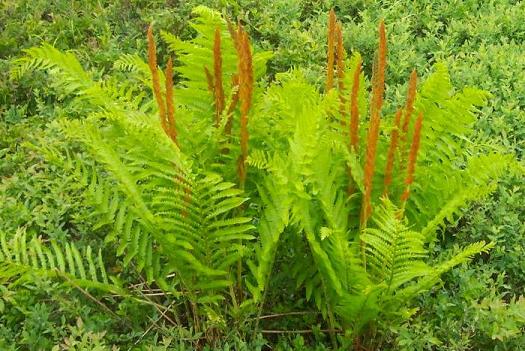
Cinnamon
Fern (Osmunda cinnamomea): Light green fronds w/cinnamon
colored fertile fronds in the center. They die off as the
fern matures. Grows in open fields, seeps and meadows. Location: Dolly
Sods, MNF,
WV,
Black Bird Knob Trail .
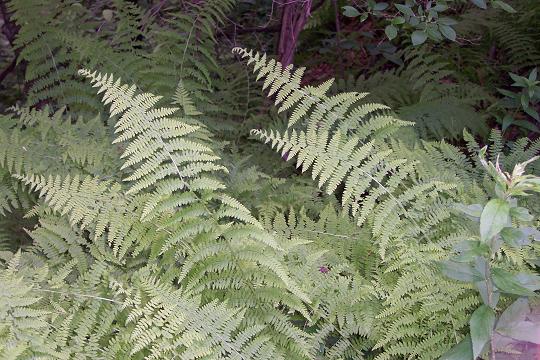
Spinulose Wood Fern (Dryopteris carthusiana): Very common. Grows to 30 inches in
dense thickets. Found in moist forests and marshes. Location
Gunpowder Loop Trail, MD.
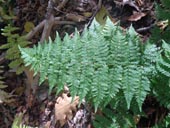
Mountain Woodfern (Dryopteris campyloptera):
Tripinnate. Stipe green, grooved with occasional brown
scales. Location: Roaring Plains, WV.
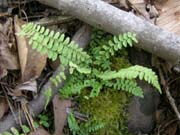
Ebony
Spleenwort (Asplenium platyneuron): Look for
the distinctive dark red stem. Location: Jug Bay,
Patuxent River, MD. Photo by Ken
Clark.
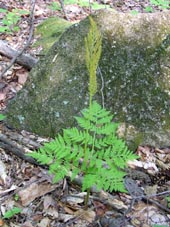
Rattlesnake Fern (Botrychium virginianum): 20
inches. Frond divided into 3 leaflets. Fertile frond
atop stalk. Location: Old Rag, SNP, VA. Photo by Ken
Clark.
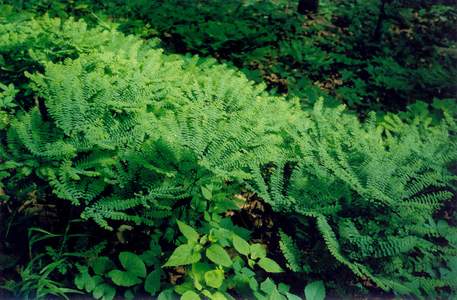
Maiden
Hair Fern (Adiantum pedatum): Moist, dark forests, limestone rocks. Blue-green
fronds with purple-black stalks. Location:
Gunpowder
South Trail, MD.
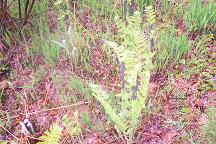
Interrupted Fern (Osmunda claytoniana) : Grows in moist areas, bogs and
swamps. Location: Moss-Hanne Tr, Black Moshannon State Park,
PA.
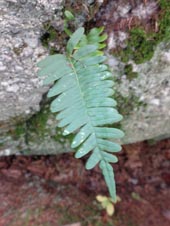
Rock Polypody (Polypodium virginianum): Grows in
cracks of large rocks, cliffs. P. appalachianum is
very similar. Location: South Prong Trail, Roaring Plains,
WV.
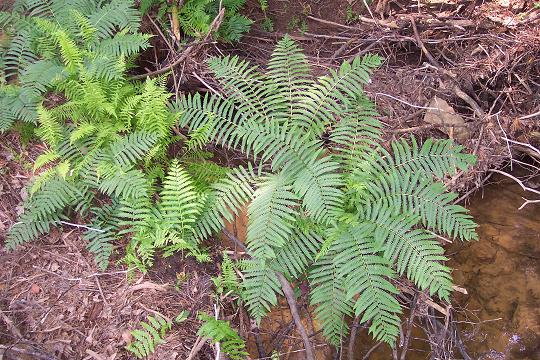
Lady Fern (Athyrium filix-femina): Grows to 4 feet. Arches outwards.
Found in clumps or thickets. Location: Lake Sherwood and
Meadow Creek Trails, MNF, WV.
|
Ferns
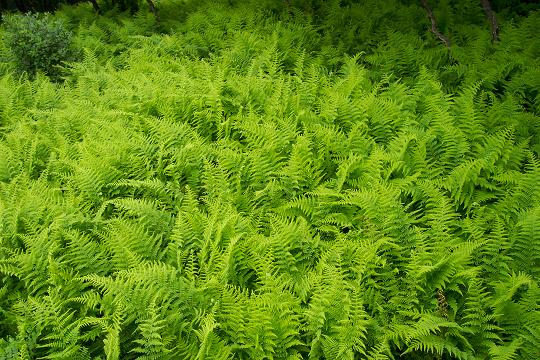
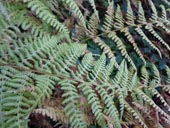
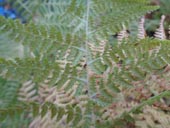
Hay scented
Fern (Dennstaedtia punctilobula): The fragrance from a field full of this fern
tells you all you need to know about the origin of its
name. Stipe green-brown. Tripinnate. Sori appear as
small gray dots (Third photo). Location: Roaring Plains, MNF, WV.
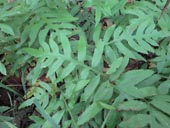
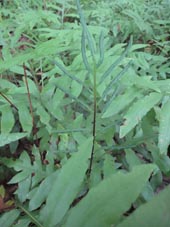
Netted Chain Fern ( Woodwardia
areolata): Similar to Sensitive Fern (below) except
leaflets are smooth, not notched. Fertile Frond is smooth
while that of Sensitive Fern looks like clusters of tiny
green grapes.

Sensitive
Fern (Onoclea sensibilis): Dies at first frost, hence its name.
Somewhat similae to Netted Chain Fern (above)
but note the notched leaflets.
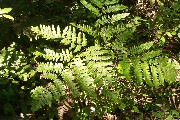
Braken Fern
(Pteridium aquilinum): Large fern with single stalk
arising from the ground with three fronds extending from the
top. Each frond in turn as several sub-fronds. Location: BFT,
PA.
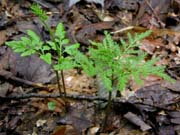
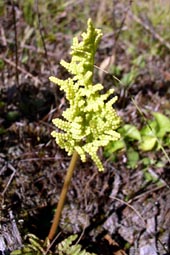
Cut-leaved
Grape Fern (Dissected Grape Fern)-
(Botrychium dissectum - Sceptridium dissectum var
obliquum) :
Cut-leaved
grape fern is variable in appearance. The plant to the right
shows the lacy leaf margin that gives this fern its name,
but some plants have smooth-edged leaves (left specimen).
Photo by Ken Clark. Sporophyll photo by Dimitri Tundra.
|
Ferns
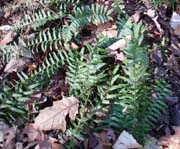
Christmas
Fern (Polystichum acrostichoides): Easy to spot in
the winter since this is one of the few evergreen ferns in
the region. Leathery pairs of leaflets on stout, woody stem.
Leaflets of each pair are somewhat offset. Begins as an
upright plant but tends to "lay down" with age. Used in
Christmas decorations. Location: Bull Run Mountain
Conservancy.
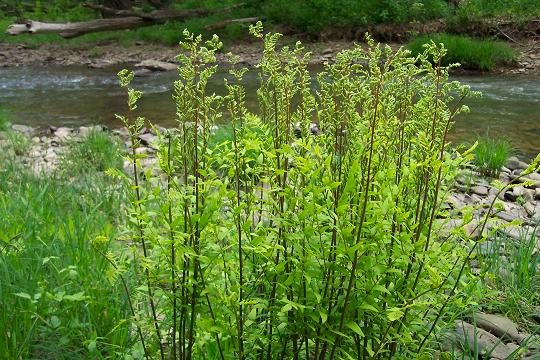
Royal Fern (Osmunda regalis): Can grow quite tall. Has opposing yet
alternating leaflets, dark stems. Tops of fronds have a
"feathery" appearance. Grows near water. Several stands were
found along Long Pond, Green Ridge SF,
MD.
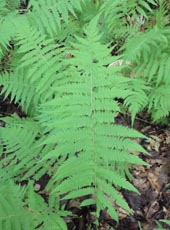
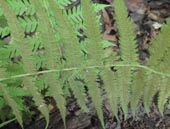
New York Fern ( Thelypteris
noveboracensis): Up to 2 feet in length. Frond tapers at
both ends. Note the brown sori on the back.
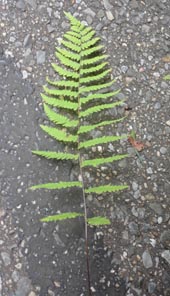
Virginia
Chain Fern (Woodwardia
virginica): Alternating leaflets, black, shinny stipe
(stem). Location: Downs Park.
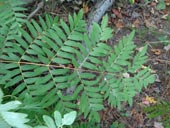
Marsh Fern
(Thelypteris palustris): Found growing in wet, rich
soil. Location: Downs Park, MD.
Lycopodiums

Southern
Running Pine (Lycopodium digitatum) Evergreen whorls
of light green. Reproduces by spores produced on club-like
stalks. (See Ground Pine below.)
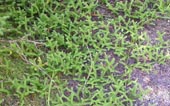
Running Ground
Pine (Lycopodium clavitum ): The name says it all. Can cover
large areas of the forest floor. Photo by Dimitri Tundra.
|
More Lycopodium
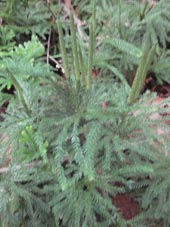
Ground Pine
(Lycopodium obscurum) Another club moss, shown here
with its club spores. They will eventually turn brown.
Others

Sweet Fern (Comptonia peregrina): Not a fern but a
wax myrtle, a shrub. Produces green burs. Location: BFT, PA.
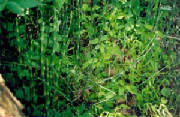
Scouring
Rush (Equisetum hyemale):
Grows around water. Previously used for cleaning cookwear.
Location: Greta Falls NP, VA.
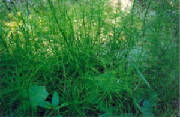
Common Horsetail (Equisetum arvense): Forest,
fields and swamps. Location: SNP, VA.
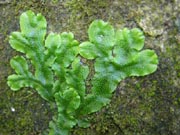
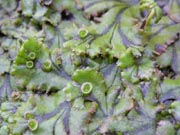 Thallose
liverworts (possibly Lunularia cruciata):
Bottom photo: showing a female gametophore in the
top right, and numerous gemma cups
containing tissue that is dispersed by rain for
asexual reproduction. Thought to be one of the first
plants to migrate from the ocean to dry land.
Location: Middle Patuxent River, Gorman area. Photo
by Ken Clark. |

